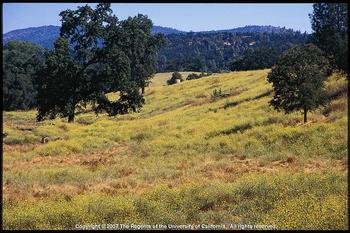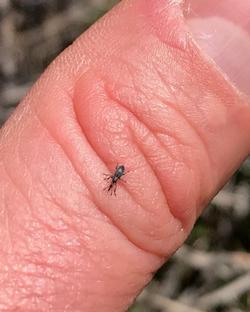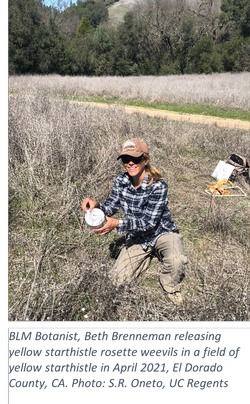Articles
A New Warrior Released in the Battle to Control Yellow Starthistle
By: Scott Oneto, University of California Cooperative Extension
In April 2021, scientists released a new weevil from the Mediterranean region of Europe at the Bureau of Land Management Magnolia Ranch day use area in El Dorado County, CA to join the battle against yellow starthistle.

Over the years, several control strategies have been developed for combating yellow starthistle including well-timed mowing, grazing with livestock (excluding horses), hand pulling, burning, cultivation, and the use of herbicides. All of these can be highly effective but are often implemented on a scale that does not equate to the severity of the population statewide. Because yellow starthistle is a prolific seed producer and the seeds can remain viable in the soil for several years, populations continue to spread when left unchecked. To have an impact on these larger infestations, often we look to biological control. Biological control involves using living organisms, such as insects, mites, or fungi, to reduce weed populations. In nature, many plants are controlled biologically in their native host range by organisms that feed on them. However, since yellow starthistle is not native to California, no biological control agents were present on its arrival. Yellow starthistle was first targeted for biological control in the 1960s. Since that time, six species of insects that attack the flower heads to reduce seed production have been introduced. These agents were found in the native host range of yellow starthistle, from Turkey and Greece throughout much of Europe and the Mediterranean basin. These insects were brought to the United States after they underwent years of research and testing and were officially permitted. It is imperative that anything approved for release be as host specific as possible without causing harm to other nontarget species. Host specificity testing focuses especially on plants closely related to the weed target. In the case of yellow starthistle, which is in the sunflower family, testing included commodities such as artichokes, sunflower, and safflower, as well as native species including thistles. The first agent introduced, the gall fly, Urophora jaculata, never established. The hairy weevil (Eustenopus villosus) and the flower weevil (Larinus curtus) are generally the most abundant agents, followed by the gall fly (Urophora sirunaseva), bud weevil (Bangasternus orientalis) and peacock fly (Chaetorellia australis). The false peacock fly (Chaetorellia succinea) was accidentally introduced in 1991, but subsequent studies indicate that it does not pose a risk to safflower or other plants native to California. A rust pathogen, Puccinia jacea var. solstitialis, was permitted and introduced to California, but it did not establish well. All these insects work by attacking the flower head where they lay their eggs, hatch, and then feed on the developing seeds, ultimately reducing seed production. Although the flower head insects sometimes attack very high proportions of flower heads, yellow starthistle is a very prolific seed producer with an individual plant producing as much as 100,000 seeds! Even if the insects reduce seed production by 50%, that still leaves a lot of seeds.


For more information about the weevil or if you have questions, contact the local University of California Cooperative Extension office at 530-621-5502 or http://cecentralsierra.ucanr.edu.
